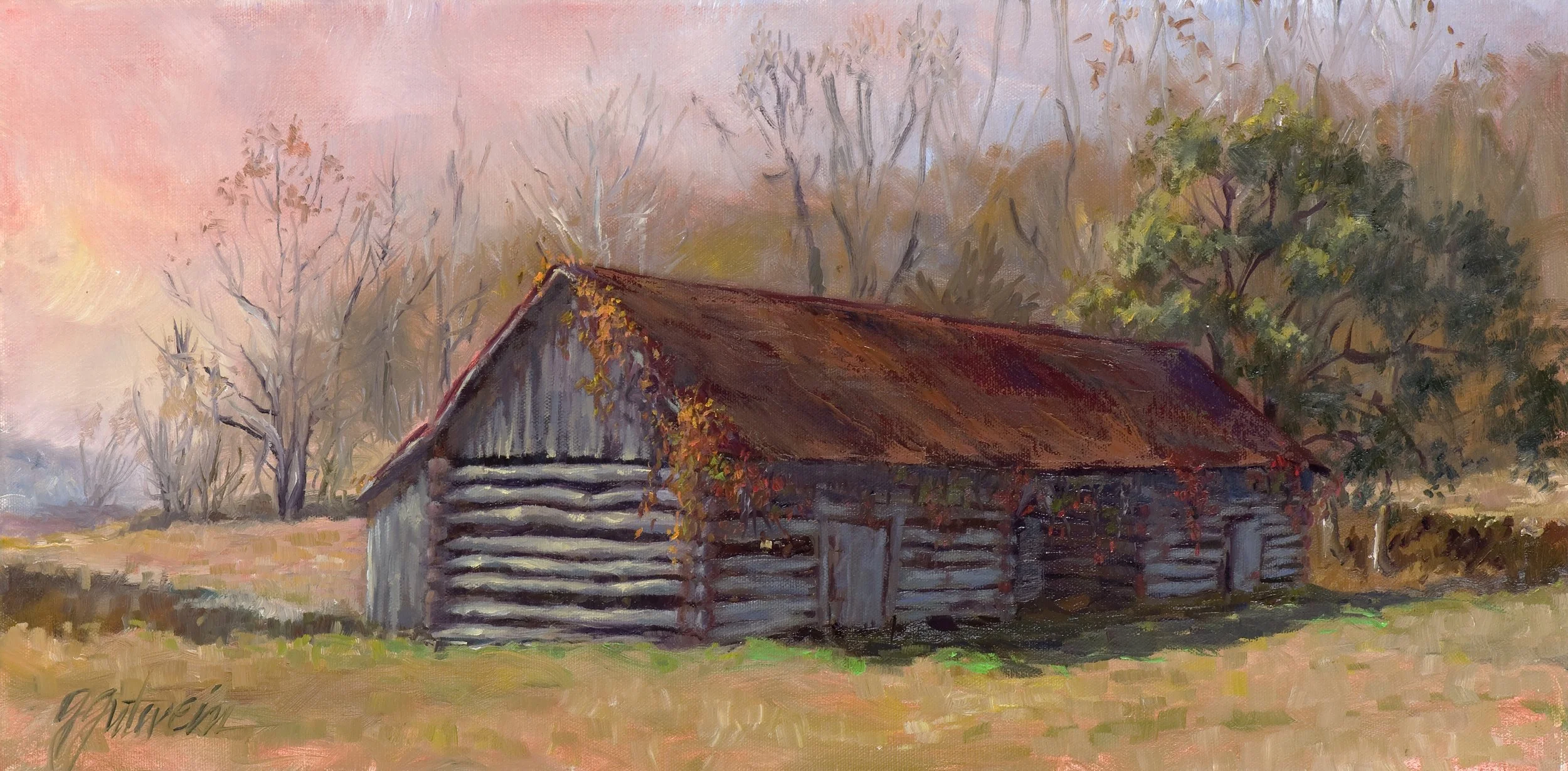The Heritage Barn Project
The Heritage Barn Project was started in 2004. Gwen embarked on a self-prescribed project to document on canvas in oil paint, historic barns throughout her home state of Indiana. Gwen had several motivations and goals. First, she felt the need and desire to hone her talents. Second, Gwen has a love of old barns stemming from her childhood. She was concerned about the demise of these historic barns and wanted to preserve these structures. She hoped her painting project would spotlight and help save these rural treasures.
The project took more than 12 years of travel and painting to complete 186 historic barn paintings. Why paint? Why not just photograph? Gwen believes our eyes see differently than a camera’s lens. Our eyes can see the delicate nuances of color within shadows and soft hues within reflected light. Our eyes see subtle variations in values.
Therefore, she chose to paint on location as much as possible. She often spent many hours and even days standing quietly observing a barn. Time to see and feel all the subtleties mentioned, but also the character of each barn to, in essence, capture the barn’s portrait.
Below are the 186 barns featured in Gwen’s published gallery book, “Heritage Barns of Indiana.” The paintings are searchable by county and each painting features a bit of history of the structure.
You can find “Heritage Barns of Indiana” online by clicking here or at various galleries and shops in Indiana. For more information about the book or Gwen’s work, please click here to contact Gwen.
All the barn paintings are for sale. Please contact Gwen to find out if the painting(s) you are interested in are sold or available.

Lee Sprunger Family Barn
This well-maintained barn is referred to as a Switzer barn or Pennsylvania barn. It is a two-level cantilevered barn dating from the late 1800s.

Swiss Heritage Museum Barn
In 1993 this Sweitzer-style barn was slowly and carefully moved from its original location to a new location in Swiss Heritage Village and although the original construction date for this barn is not known, estimations place it in the late 1800s.

Badiac-Willowbrook Barn
This stately cantilevered bank barn was strategically planted into the crown of a gentle hill providing a commanding. The Badiac family owned this farm and it is believed they built the barn.

Coleman Family Barn
In 1835, Nathan Coleman, an Allen County judge, purchased the land where this barn stands. His daughter Louisa inherited the farm. She married Charles Doctor and had al number of children, one of whom was Henry Doctor.

Mendenhall Family Barn
This beautiful red barn, built in 1865, has seen seven generations of the same family. Unusual though true, it has passed through the female side. It is a well-maintained gable barn with two very ornate cupolas gracing the roof's ridge.

Salomon Farm Barn
This large and stately barn was built in 1871 and is a pass-through barn with stone foundation. Animals used the lower level; the access doors are located on the north end of the barn.

Towpath Mule Barn
If this little barn could talk, it would captivate an audience with its stories, beginning with a front row seat along the Wabash and Erie Canal.

Rentschler Barn
The exact construction date for this unique gable bank barn is unknown. Estimations place it in the 1880s. It is a 45-foot square barn.

Thompson-Armstrong Barn
For those with an eye for historic buildings, especially barns, a first glance gives thought to the past and future of this pre-Civil War Barn.

Olheiser Family Barn
Even with the little bit of history known about this barn, it emits an easy-to-see charm that was designed into its functionality. Its construction date is unknown.

Wetli Family Barn
The Wetli family built this barn in 1942; it replaced an older barn that stood nearby. It is a two-story gable barn. The upper level loft is used for hay storage and the ground floor is home to newborn calves.

Bugh-Creek Barn
A storm was brewing the summer afternoon when I arrived at the Jon Creek Farm to complete a plein air painting of the barn. The dark sky looms over the barn in the painting.

Willman Brothers Farm Barn
Gently rolling and fertile hills surround this family farm. It has been in the Willman family since 1855. This barn was built in 1912-13.

Marshall Family Brick Barn
This well-maintained barn is quite eye-catching. The unique construction features bricks topped with a hip root of asphalt shingles.

Sycamore Hill Barn on the Pryor Brock Homestead
The exact age of this bank barn is unknown; however, it appears to be one of the earlier barns in the region. It is surrounded by fertile and beautiful farmland.

Spiker-Fitzgerald Log Barn
Nestled between two wooded ridges and place along a small stream, this old log barn rests in a beautiful little valley in southern Indiana.

Vera Evelyn Deckard Barn
Driving the winding grass-filled lane up to this barn is a peaceful pleasure.

McCain-Mears Barn
Carroll County is fortunate to have this barn treasure within its boundaries. The family believes the barn was built around 1862. It is cantilevered bank barn.

William Jones Family Barn
While the word “barn” immediately paints a picture of big and red, every now and then we do discover what are known as "rare" finds.

McCready Farmall Barn
Positioned well away from the highway, this barn proudly displays its favorite tractor on its arched roof. Asphalt composite shingles were popular at the time in and around Cass County.
Click below to search for paintings from
the Heritage Barn Project by county.
Owen
Parke
Perry
Pike
Porter
Posey
Pulaski
Putnam
Randolph
Ripley
Rush
Scott
Shelby
Spencer
St. Joseph
Starke
Steuben
Sullivan
Switzerland
Tippecanoe
Tipton
Union
Vanderburgh
Vermillion
Vigo
Wabash
Warren
Warrick
Washington
Wayne
Wells
White
Whitley
